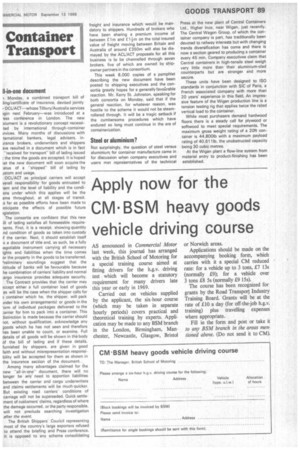Container Transport
Page 91

If you've noticed an error in this article please click here to report it so we can fix it.
II-in-one document 1 Monday, a combined transport bill of ling/certificate of insurance, devised jointly OCL/ACT—whose Tilbury/Australia services ;gin next February—was introduced at a 'ess conference in London. The new )cument is a revolutionary concept necessited by international through-container ;rvices. Many months of discussions with ternational bankers, legal advisers, inirance brokers, underwriters and shippers 3ve resulted in a document which is in fact "received for transport" bill of lading issued : the time the goods are accepted. It is hoped lat the new document will soon acquire the .atus of a "shipped' bill of lading by JStOM and usage.
°Ct./ACT as principal carriers will accept verall responsibility for goods entrusted to ;ern and the level of liability and the condions under which this applies will be the 3me throughout, at all stages of transit. s far as possible efforts have been made to nticipate the effects of possible future ;gislation.
The consortia are confident that this new ill of lading satisfies all foreseeable require-lents. First, it is a receipt, showing quantity nd condition of goods as taken into custody 1 the carrier. Next, it should establish itself $ a document of title and, as such, be a fully legotiable instrument carrying all necessary ights and liabilities when the time comes or the property in the goods to be transferred. 'reliminary soundings suggest that the ittitude of banks will be favourable because he combination of carriers' liability and normal :ergo insurance provides adequate security.
The Contract provides that the carrier may ;ccept either a full container load of goods as will be the case when the shipper calls for 3 container which he. the shipper, will pack mder his own arrangements) or goods in the -orm of individual packages delivered to the ;arrier for him to pack into a container. This distinction is made because the carrier should riot, without qualification, acknowledge any goods which he has not seen and therefore has been unable to count, or examine. Full details of all goods will be shown in the body of the bill of lading and if these details, furnished by shippers, are given in good faith and without misrepresentation responsibility will be accepted for them as shown in the insurance section of the document.
Among many advantages claimed for the new "all-in-one" document, there will no longer be any need to apportion liabilities between the carrier and cargo underwriters and claims settlements will be much quicker. But existing road carriers' conditions of carriage will not be superseded. Quick settlement of customers' claims, regardless of where the damage occurred, or the party responsible, will not preclude searching investigation after the event.
The British Shippers' Council representing most of the country's large exporters refused to attend the briefing and Press conference. It is opposed to any scheme consolidating freight and insurance which would be mandatory to shippers. Hundreds of brokers who have been sharing a premium income of between Elm and £1 3-m on the total insured value of freight moving between Britain and Australia of around £350m will also be dismayed by the ACL/ACT proposals for all this business is to be channelled through seven brokers, five of which are owned by shipowner partners in the consortium.
This week 8,000 copies of a pamphlet describing the new document have been posted to shipping executives and the consortia greatly hopes for a generally favoi.irable reaction. Mr. Kerry St. Johnston, speaking for both consortia on Monday, said that if the general reaction, for whatever reason, was hostile to the scheme it would not be steamrollered through. It will be a tragic setback if the cumbersome procedures which have endured so long must continue in the era of containerization.
Steel or aluminium?
Not surprisingly, the question of steel versus aluminium for container manufacture came in for discussion when company executives and users met representatives of the technical Press at the new plant of Central Containers Ltd., Higher Ince, near Wigan, just recently. The Central Wagon Group, of which the container company is part, has traditionally been devoted to railway interests but with changing trends diversification has come and there is now a section geared to producing a container every 45 min. Company executives claim that Central containers in high-tensile steel weigh very little more than their aluminium-clad counterparts but are stronger and more secure.
These units have been designed to ISO standards in conjunction with SIC of Paris, a French associated company with more than 20 years' experience in this field. An impressive feature of the Wigan production line is a tension testing rig that applies twice the rated vertical load to the container.
While most purchasers demand hardwood floors there is a steady call for plywood or softwood to meet special requirements. The maximum gross weight rating of a 20ft container is 44,800lb with a maximum payload rating of 40,6111b, the unobstructed capacity being 30 cubic metres.
At the Wigan plant a flow-line system from material entry to product-finishing has been established.




































































































































































































































































